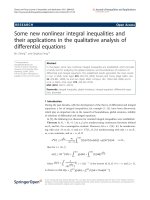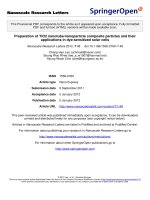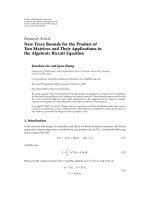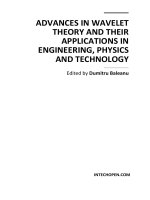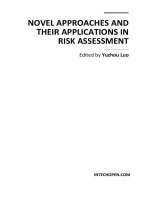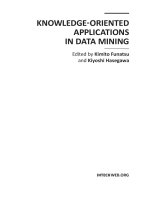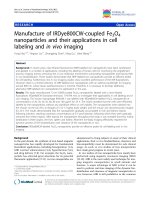IT training nonlinear integrals and their applications in data mining wang, yang leung 2010 06 09
Bạn đang xem bản rút gọn của tài liệu. Xem và tải ngay bản đầy đủ của tài liệu tại đây (5.86 MB, 359 trang )
Advances in Fuzzy Systems — Applications and Theory – Vol. 24
ADVANCES IN FUZZY SYSTEMS — APPLICATIONS AND THEORY
Honorary Editor: Lotfi A. Zadeh (Univ. of California, Berkeley)
Series Editors:
Kaoru Hirota (Tokyo Inst. of Tech.),
George J. Klir (Binghamton Univ.– SUNY ),
Elie Sanchez (Neurinfo),
Pei-Zhuang Wang (West Texas A&M Univ.),
Ronald R. Yager (Iona College)
Published
Vol. 9: Fuzzy Topology
(Y. M. Liu and M. K. Luo)
Vol. 10: Fuzzy Algorithms: With Applications to Image Processing and
Pattern Recognition
(Z. Chi, H. Yan and T. D. Pham)
Vol. 11: Hybrid Intelligent Engineering Systems
(Eds. L. C. Jain and R. K. Jain)
Vol. 12: Fuzzy Logic for Business, Finance, and Management
(G. Bojadziev and M. Bojadziev)
Vol. 13: Fuzzy and Uncertain Object-Oriented Databases: Concepts and Models
(Ed. R. de Caluwe)
Vol. 14: Automatic Generation of Neural Network Architecture Using
Evolutionary Computing
(Eds. E. Vonk, L. C. Jain and R. P. Johnson)
Vol. 15: Fuzzy-Logic-Based Programming
(Chin-Liang Chang)
Vol. 16: Computational Intelligence in Software Engineering
(W. Pedrycz and J. F. Peters)
Vol. 17: Nonlinear Integrals and Their Applications in Data Mining
(Z. Y. Wang, R. Yang and K.-S. Leung)
Vol. 18: Factor Space, Fuzzy Statistics, and Uncertainty Inference (Forthcoming)
(P. Z. Wang and X. H. Zhang)
Vol. 19: Genetic Fuzzy Systems, Evolutionary Tuning and Learning
of Fuzzy Knowledge Bases
(O. Cordón, F. Herrera, F. Hoffmann and L. Magdalena)
Vol. 20: Uncertainty in Intelligent and Information Systems
(Eds. B. Bouchon-Meunier, R. R. Yager and L. A. Zadeh)
Vol. 21: Machine Intelligence: Quo Vadis?
(Eds. P. Sincák, J. Vascák and K. Hirota)
Vol. 22: Fuzzy Relational Calculus: Theory, Applications and Software
(With CD-ROM)
(K. Peeva and Y. Kyosev)
ˆˆ
ˆ
Vol. 23: Fuzzy Logic for Business, Finance and Management (2nd Edition)
(G. Bojadziev and M. Bojadziev)
Advances in Fuzzy Systems — Applications and Theory – Vol. 24
Nonlinear Integrals
and Their Applications
in Data Mining
Zhenyuan Wang
University of Nebraska at Omaha, USA
Rong Yang
Shen Zhen University, China
Kwong-Sak Leung
Chinese University of Hong Kong, China
World Scientific
NEW JERSEY
•
LONDON
•
SINGAPORE
•
BEIJING
•
SHANGHAI
•
HONG KONG
•
TA I P E I
•
CHENNAI
Published by
World Scientific Publishing Co. Pte. Ltd.
5 Toh Tuck Link, Singapore 596224
USA office: 27 Warren Street, Suite 401-402, Hackensack, NJ 07601
UK office: 57 Shelton Street, Covent Garden, London WC2H 9HE
British Library Cataloguing-in-Publication Data
A catalogue record for this book is available from the British Library.
NONLINEAR INTEGRALS AND THEIR APPLICATIONS IN DATA MINING
Advances in Fuzzy Systems – Applications and Theory — Vol. 17
Copyright © 2010 by World Scientific Publishing Co. Pte. Ltd.
All rights reserved. This book, or parts thereof, may not be reproduced in any form or by any means,
electronic or mechanical, including photocopying, recording or any information storage and retrieval
system now known or to be invented, without written permission from the Publisher.
For photocopying of material in this volume, please pay a copying fee through the Copyright
Clearance Center, Inc., 222 Rosewood Drive, Danvers, MA 01923, USA. In this case permission to
photocopy is not required from the publisher.
ISBN-13 978-981-281-467-8
ISBN-10 981-281-467-1
Printed in Singapore by Mainland Press Pte Ltd.
To our families
v
This page intentionally left blank
Preface
The theory of nonadditive set functions and relevant nonlinear integrals,
as a new mathematics branch, has been developed for more than thirty
years. Starting from the beginning of the nineties of the last century,
several monographs were published. The first author of this monograph
and Professor George J. Klir (The State University of New York
at Binghamton) have published two books, Fuzzy Measure Theory
(Plenum Press, New York, 1992) and Generalized Measure Theory
(Springer-verlag, New York, 2008) on this topic. These two books
cover most of their theoretical research results with colleagues at the
Chinese University of Hong Kong in the area of nonadditive set
functions and relevant nonlinear integrals. Since the 1980s, nonadditive
set functions and nonlinear integrals have been successfully applied in
information fusion and data mining. However, only a few applications
are involved in the above-mentioned books. As a supplement and indepth material, the current monograph, Nonlinear Integrals and Their
Applications in Data Mining, concentrates on the applications in data
analysis. Since the number of attributes in any database is always finite,
we focus on our fundamentally theoretical discussion of nonadditive set
function and nonlinear integrals, which are presented in the first several
chapters, on the finite universal set, and abandon all convergence and
limit theorems.
As for the terminology adopted in the current monograph, words like
monotone measure is used for a set function that is nonnegative,
monotonic, and vanishing at the empty set. It has no fuzziness in the
meaning of Zadeh’s fuzzy sets. Unfortunately, its original name is fuzzy
measure in literature. Word “fuzzy” here is not proper. For example,
vii
viii
Preface
words “fuzzy-valued fuzzy measure defined on fuzzy sets” causes
confusion to some people. Such a revision is the same as made in book
Generalized Measure Theory. However, in this monograph, we prefer to
use efficiency measure to name a set function that is nonnegative and
vanishing at the empty set, rather than using general measure. This is
more convenient and intuitive, and leaves more space for further
generalizing the domain or the range of the set functions. Hence, similar
to the classical case in measure theory [Halmos 1950], the set functions
that vanish at the empty set and may assume both nonnegative and
negative real values are naturally named as signed efficiency measures.
The signed efficiency measures were also called non-monotonic fuzzy
measures by some scholars. Since, in general, the efficiency measures
are non-monotonic too, to distinguish the set functions satisfying only
the condition of vanishing at the empty set from the efficiency measures
and to emphasize that they can assume both positive and negative values
as well as zero, we prefer to use the current name, signed efficiency
measures, for this type of set functions with the weakest restriction.
Thus, in this monograph, we discuss and apply three layers of set
functions named monotone measures, efficiency measures, and signed
efficiency measures respectively.
The contents of this monograph have been used as the teaching
materials of two graduate level courses at the University of Nebraska at
Omaha since 2004. Also, some parts of this monograph have been
provided to a number of master degree and Ph.D. degree graduate
students in the University of Nebraska at Omaha, the University of
Nebraska at Lincoln, the Chinese University of Hong Kong, and the
Chinese Academy Sciences, for preparing their dissertations.
This monograph may benefit the relevant research workers. It is also
possible to be used as a textbook of some graduate level courses for both
mathematics and engineering major students. A number of exercises on
the basic theory of nonadditive set functions and relevant nonlinear
integrals are available in Chapters 2–5 of the monograph.
Several former graduate students of the first author provided
some algorithms, examples, and figures. We appreciate their valuable
contributions to this monograph. We also thank the Department of
Computer Science and Engineering of the Chinese University of Hong
Preface
ix
Kong, the Department of System Science and Industrial Engineering
of the State University of New York at Binghamton and, especially,
the Department of Mathematics, as well as the Art and Science College
of the University of Nebraska at Omaha for their support and help.
Zhenyuan Wang
Rong Yang
Kwong-Sak Leung
This page intentionally left blank
Contents
Preface ............................................................................................................................. vii
List of Tables ................................................................................................................... xv
List of Figures ................................................................................................................. xvi
Chapter 1: Introduction ...................................................................................................... 1
Chapter 2: Basic Knowledge on Classical Sets .................................................................. 4
2.1 Classical Sets and Set Inclusion .............................................................................. 4
2.2 Set Operations ......................................................................................................... 7
2.3 Set Sequences and Set Classes .............................................................................. 10
2.4 Set Classes Closed Under Set Operations ............................................................. 13
2.5 Relations, Posets, and Lattices .............................................................................. 17
2.6 The Supremum and Infimum of Real Number Sets .............................................. 20
Exercises ..................................................................................................................... 22
Chapter 3: Fuzzy Sets ...................................................................................................... 24
3.1 The Membership Functions of Fuzzy Sets ............................................................ 24
3.2 Inclusion and Operations of Fuzzy Sets ................................................................ 27
3.3 α-Cuts ................................................................................................................... 33
3.4 Convex Fuzzy Sets ................................................................................................ 36
3.5 Decomposition Theorems...................................................................................... 37
3.6 The Extension Principle ........................................................................................ 40
3.7 Interval Numbers ................................................................................................... 42
3.8 Fuzzy Numbers and Linguistic Attribute .............................................................. 45
3.9 Binary Operations for Fuzzy Numbers .................................................................. 51
3.10 Fuzzy Integers ..................................................................................................... 58
Exercises ..................................................................................................................... 59
Chapter 4: Set Functions .................................................................................................. 62
4.1 Weights and Classical Measures ........................................................................... 63
4.2 Extension of Measures .......................................................................................... 66
4.3 Monotone Measures .............................................................................................. 69
4.4 λ-Measures ............................................................................................................ 74
xi
xii
Contents
4.5 Quasi-Measures ..................................................................................................... 82
4.6 Möbius and Zeta Transformations ........................................................................ 87
4.7 Belief Measures and Plausibility Measures ........................................................... 91
4.8 Necessity Measures and Possibility Measures .................................................... 102
4.9 k-Interactive Measures ........................................................................................ 107
4.10 Efficiency Measures and Signed Efficiency Measures ...................................... 108
Exercises ................................................................................................................... 112
Chapter 5: Integrations................................................................................................... 115
5.1 Measurable Functions ......................................................................................... 115
5.2 The Riemann Integral .......................................................................................... 123
5.3 The Lebesgue-Like Integral ................................................................................ 128
5.4 The Choquet Integral........................................................................................... 133
5.5 Upper and Lower Integrals .................................................................................. 153
5.6 r-Integrals on Finite Spaces................................................................................. 162
Exercises ................................................................................................................... 174
Chapter 6: Information Fusion ....................................................................................... 177
6.1 Information Sources and Observations................................................................ 177
6.2 Integrals Used as Aggregation Tools .................................................................. 181
6.3 Uncertainty Associated with Set Functions ......................................................... 186
6.4 The Inverse Problem of Information Fusion ....................................................... 190
Chapter 7: Optimization and Soft Computing................................................................ 193
7.1 Basic Concepts of Optimization .......................................................................... 193
7.2 Genetic Algorithms ............................................................................................. 195
7.3 Pseudo Gradient Search ...................................................................................... 199
7.4 A Hybrid Search Method .................................................................................... 202
Chapter 8: Identification of Set Functions ..................................................................... 204
8.1 Identification of λ-Measures ............................................................................... 204
8.2 Identification of Belief Measures ........................................................................ 206
8.3 Identification of Monotone Measures.................................................................. 207
8.3.1 Main algorithm.......................................................................................... 210
8.3.2 Reordering algorithm ................................................................................ 211
8.4 Identification of Signed Efficiency Measures by a Genetic Algorithm ............... 213
8.5 Identification of Signed Efficiency Measures by the Pseudo Gradient Search .... 215
8.6 Identification of Signed Efficiency Measures Based on the Choquet Integral
by an Algebraic Method..................................................................................... 217
8.7 Identification of Monotone Measures Based on r-Integrals by a Genetic
Algorithm........................................................................................................... 219
Chapter 9: Multiregression Based on Nonlinear Integrals ............................................. 221
9.1 Linear Multiregression ........................................................................................ 221
Contents
xiii
9.2 Nonlinear Multiregression Based on the Choquet Integral.................................. 226
9.3 A Nonlinear Multiregression Model Accommodating Both Categorical
and Numerical Predictive Attributes .................................................................. 232
9.4 Advanced Consideration on the Multiregression Involving Nonlinear
Integrals ............................................................................................................. 234
9.4.1 Nonlinear multiregressions based on the Choquet integral with
quadratic core......................................................................................... 234
9.4.2 Nonlinear multiregressions based on the Choquet integral involving
unknown periodic variation ................................................................... 235
9.4.3 Nonlinear multiregressions based on upper and lower integrals ............... 236
Chapter 10: Classifications Based on Nonlinear Integrals ............................................. 238
10.1 Classification by an Integral Projection............................................................. 238
10.2 Nonlinear Classification by Weighted Choquet Integrals ................................. 242
10.3 An Example of Nonlinear Classification in a Three-Dimensional Sample
Space .................................................................................................................. 250
10.4 The Uniqueness Problem of the Classification by the Choquet Integral
with a Linear Core ............................................................................................. 263
10.5 Advanced Consideration on the Nonlinear Classification Involving the
Choquet Integral ................................................................................................ 267
10.5.1 Classification by the Choquet integral with the widest gap between
classes .................................................................................................... 267
10.5.2 Classification by cross-oriented projection pursuit ................................. 268
10.5.3 Classification by the Choquet integral with quadratic core ..................... 270
Chapter 11: Data Mining with Fuzzy Data .................................................................... 272
11.1 Defuzzified Choquet Integral with Fuzzy-Valued Integrand (DCIFI) ............... 273
11.1.1 The α-level set of a fuzzy-valued function.............................................. 274
11.1.2 The Choquet extension of µ .................................................................... 275
11.1.3 Calculation of DCIFI .............................................................................. 277
11.2 Classification Model Based on the DCIFI ......................................................... 282
11.2.1 Fuzzy data classification by the DCIFI ................................................... 283
11.2.2 GA-based adaptive classifier-learning algorithm via DCIFI
projection pursuit ................................................................................... 286
11.2.3 Examples of the classification problems solved by the DCIFI
projection classifier ................................................................................ 290
11.3 Fuzzified Choquet Integral with Fuzzy-Valued Integrand (FCIFI) ................... 300
11.3.1 Definition of the FCIFI ........................................................................... 300
11.3.2 The FCIFI with respect to monotone measures ....................................... 303
11.3.3 The FCIFI with respect to signed efficiency measures............................ 306
11.3.4 GA-based optimization algorithm for the FCIFI with respect to
signed efficiency measures .................................................................... 309
xiv
Contents
11.4 Regression Model Based on the CIII................................................................. 319
11.4.1 CIII regression model.............................................................................. 319
11.4.2 Double-GA optimization algorithm ........................................................ 321
11.4.3 Explanatory examples ............................................................................. 324
Bibliography .................................................................................................................. 329
Index .............................................................................................................................. 337
List of Tables
Table 6.1 Iris data (from ............ 179
Table 6.2 Data of working times in Example 6.4 ........................................................... 183
Table 6.3 The scores of TV sets in Example 6.5 ............................................................ 184
Table 10.1 Data for linear classification in Example 10.1 ............................................. 241
Table 10.2 Artificial training data in Example 10.7 ....................................................... 252
Table 10.3 The preset and retrieved values of monotone measure µ and weights b....... 259
Table 10.4 Data and their projections in Example 10.8 ................................................. 266
Table 11.1 Preset and retrieved values of the signed efficiency measure and
boundaries in Example 11.4 ......................................................................... 293
Table 11.2 Preset and retrieved values of the signed efficiency measure and
boundaries in Example 11.5 ........................................................................ 294
Table 11.3 The estimated values of the signed efficiency measure and the virtual
boundary in two-emitter identification problem .......................................... 297
Table 11.4 Testing results on two-emitter identification problem with/without noise ... 298
Table 11.5 The estimated values of the signed efficiency measure and the virtual
boundary in three-emitter identification problem ........................................ 299
Table 11.6 Testing results on three-emitter identification problem with/without
noise ............................................................................................................ 299
Table 11.7 Values of the signed efficiency measure µ in Example 11.13 ..................... 318
Table 11.8 Results of 10 trials in Example 11.14........................................................... 326
Table 11.9 Comparisons of the preset and the estimated unknown parameters of the
best trial in Example 11.14 .......................................................................... 326
Table 11.10 Results of 10 trials in Example 11.15......................................................... 327
Table 11.11 Comparisons of the preset and the estimated unknown parameters of
the best trial in Example 11.15 .................................................................... 327
xv
List of Figures
Figure 1.1
Figure 2.1
Figure 3.1
Figure 3.2
Figure 3.3
Figure 3.4
Figure 3.5
Figure 3.6
Figure 3.7
Figure 3.8
Figure 3.9
Figure 3.10
Figure 3.11
Figure 3.12
Figure 3.13
Figure 3.14
Figure 5.1
Figure 5.2
Figure 5.3
Figure 5.4
Figure 5.5
Figure 5.6
Figure 5.7
Figure 5.8
Figure 7.1
Figure 7.2
The relation among chapters........................................................................... 3
Relations among classes of sets .................................................................... 15
The membership function of Y ................................................................... 25
The membership function of O ................................................................... 26
The membership function of Y ................................................................... 30
The membership function of M .................................................................. 30
Membership functions of a~b , a~w , a~ f , a~g , a~e . ........................................... 32
The α-cut and strong α-cut of fuzzy set Y when α = 0.5 ............................... 33
2
An α-cut of convex fuzzy set with membership function m( x) = e − x .......... 38
The membership function of D+F obtained by the extension principle. ...... 43
The membership function of a rectangular fuzzy number ............................ 47
The membership function of a triangular fuzzy number. .............................. 49
The membership function of a trapezoidal fuzzy number............................. 49
The membership function of a cosine fuzzy number. ................................... 50
Membership functions in Example 3.18 ....................................................... 56
Membership functions in Example 3.19 ....................................................... 57
The geometric meaning of a definite integral ............................................. 125
The calculation of the Choquet integral defined on a finite set
{x1, x2 , x3} ...................................................................................................... 138
The chain used in the calculation of the Choquet integral in
Example 5.7 ................................................................................................. 139
The partition of f corresponding to the Choquet integral in
Example 5.17. .............................................................................................. 164
The partition of f corresponding to the Lebesgue integral in
Example 5.18. .............................................................................................. 166
The partition of f corresponding to the upper integral in Example 5.19. .... 169
The partition of f corresponding to the lower integral in Example 5.20. .... 170
The partitions corresponding to various types of nonlinear integrals in
Example 5.21. ............................................................................................. 173
Illustration of genetic operators .................................................................. 198
The flowchart of genetic algorithms ........................................................... 198
xvi
List of Figures
xvii
Figure 8.1 The lattice structure for the power set of a universal set with 4
attributes ..................................................................................................... 211
Figure 10.1 The training data and one optimal classifying boundaries x1+2x2 = 1.4
with a new sample (0.3, 0.7) in Example 10.1 ............................................ 241
Figure 10.2 Interaction between length and width of envelops in Example 10.2........... 243
Figure 10.3 The contours of the Choquet integral in Example 10.3 .............................. 244
Figure 10.4 The projection by the Choquet integral in Example 10.3 ........................... 245
Figure 10.5 A contour of the Choquet integral with respect to a signed efficiency
measure in Example 10.4............................................................................ 246
Figure 10.6 Contours of the Choquet integral with respect to a subadditive
efficiency measure in Example 10.5 ........................................................... 247
Figure 10.7 Projection line and Contours of the weighted Choquet integral in
Example 10.6 .............................................................................................. 249
Figure 10.8 View classification in Example 10.7 from three different directions.......... 260
Figure 10.9 The distribution of the projection Yˆ on axis L based on the training
data set in Example 10.7 ............................................................................. 261
Figure 10.10 The convergence of the genetic algorithm in Example 10.7 with
different population sizes .......................................................................... 262
Figure 10.11 Different projections share the same classifying boundary in
Example 11.8 ............................................................................................ 265
Figure 10.12 Two-class two-dimensional data set that can be well classified by
cross-oriented projection pursuit ............................................................... 271
Figure 10.13 Two-class three-dimensional data set that can be well classified by
cross-oriented projection pursuit ............................................................... 271
Figure 11.1 The α-level set of a fuzzy-valued function in Example 11.1 ....................... 275
Figure 11.2 A typical 2-dimensional heterogeneous fuzzy data .................................... 284
Figure 11.3 The DCIFI projection for 2-dimensional heterogeneous fuzzy data ........... 285
Figure 11.4 Illustration of virtual projection axis L when determining the
boundary of a pair of successive classes C k i and C ki +1 : (a) when
Yˆ * ( k i ) ≤ Yˆ * ( k i + 1 ) ; (b) when Yˆ * ( k i ) > Yˆ * ( k i + 1 ) ........................................ 288
Figure 11.5 Flowchart of the GACA ............................................................................. 289
Figure 11.6 The training data and the trained classifying boundaries in
Example 11.4 .............................................................................................. 293
Figure 11.7 Artificial data and the classification boundaries in Example 11.5
from two view directions ............................................................................ 295
~
Figure 11.8 Relationship between f and f α ............................................................... 301
Figure 11.9 The membership functions and α-cut function of ~f in Example 11.6 ........ 302
Figure 11.10 The membership functions of the Choquet integral with triangular
fuzzy-valued integrand in Example 11.7 .................................................. 305
Figure 11.11 The membership functions of the Choquet integral with normal fuzzyvalued integrand in Example 11.8 ............................................................. 306
Figure 11.12 Description of terminal ranges when µ is a signed efficiency measure..... 308
xviii
List of Figures
Figure 11.13 Correspondence in coding method ............................................................ 310
Figure 11.14 Distance definition on calculation of the left and the right terminals of
(C) ∫ f dµ .................................................................................................. 311
~
~
Figure 11.15 Membership functions of f ( x1 ) and f ( x 2 ) in Example 11.11 ............... 315
Figure 11.16 The membership functions of (C) ∫ f dµ in Example 11.11 ..................... 315
~
~
Figure 11.17 Membership functions of f ( x1 ) and f ( x 2 ) in Example 11.12 ............... 316
Figure 11.18 The membership functions of (C) ∫ f dµ in Example 11.12 ..................... 317
Figure 11.19 Membership function of (C) ∫ f dµ in Example 11.13.............................. 318
Figure 11.20 Structure of an individual chromosome in the double-GA optimization
algorithm ................................................................................................... 322
Figure 11.21 Benchmark model in Examples 11.14 and 11.15 ...................................... 325
Chapter 1
Introduction
The traditional aggregation tool in information treatment is the weighted
average, or more general, the weighted sum. That is, if the numerical
information received from diverse information sources x1 , x2 , L , xn
are f ( x1 ), f ( x2 ), L, f ( xn ) respectively, then the synthetic amount,
weighted sum y, of the information is calculated by
y = w1 f ( x1 ) + w2 f ( x2 ) + L + wn f ( xn ) ,
(1.1)
where w1 , w2 , L, wn are the weights of x1 , x2 , L, xn , respectively.
When 0 ≤ wi ≤ 1 for i = 1, 2, L, n and ∑ in=1 wi = 1 , the weighted sum
shown in (1.1) is called the weighted average. In databases, these
information sources x1 , x2 , L, xn are regarded as attributes and
f ( x1 ), f ( x2 ), L, f ( xn ) are their observations (or say, their records),
respectively. An observation can be considered as a function defined on
the finite set consisting of these involved information sources. Thus, the
weighted sum, essentially, is the Lebesgue integral defined on the set of
information sources and is a linear aggregation model. The linear models
have been widely applied in information fusion and data mining, such as
in multiregression, multi-objective decision making, classification,
clustering, Principal Components Analysis (PCA), and so on. However,
using linear methods need a basic assumption that there is no interaction
among the contributions from individual attributes towards a certain
target, such as the objective attribute in regression problems or the
classifying attribute in classification problems. This interaction is totally
1
2
Nonlinear Integrals and Their Applications in Data Mining
different from the correlationship in statistics. The latter is used to
describe the relation between the appearing values of two considered
attributes and is not related to any target attribute.
To describe the interaction among contributions from attributes
towards a certain target, the concept of nonadditive set functions, such as
λ-measures (called λ-fuzzy measure during the seventies and eighties of
the last century), belief measures, possibility measures, monotone
measures, and efficiency measures have been introduced. The systematic
investigation on nonadditive set functions started thirty five years ago. At
that time, they were called fuzzy measures. Noticeably, the traditional
aggregation tool, the weighted sum, fails when the above-mentioned
interaction cannot be ignored and some new types of integrals, such as
the Choquet integral, the upper integral and the lower integral, should be
adopted. In general, these integrals are nonlinear and are generalizations
of the classical Lebesgue integral in the sense that they coincide with the
Lebesgue integral when the involved nonadditive measure is simply
additive. The fuzzy integral, which was introduced in 1974, is also a
special type of nonlinear integrals with respect to so-called fuzzy
measures. Since the fuzzy integral adopts the maximum and minimum
operators, but not the common addition and the common multiplication,
most people do not prefer to use the fuzzy integral in real problems.
Currently, the most common nonlinear integral in use is the Choquet
integral. It has been widely applied in information fusion and data
mining, such as the nonlinear multiregressions and the nonlinear
classifications, successfully. However, the corresponding algorithms are
relatively complex. Only the traditional algebraic methods are not
sufficient to solve most data mining problems based on nonlinear
integrals. Some newly introduced soft computing techniques, such as the
genetic algorithm and the pseudo gradient search, which are presented in
Chapter 7 of this monograph, must be adopted.
In most real problems, there are only finitely many variables. For
example, in any real database, there are only finitely many attributes. So,
the part of fundamental theory in this monograph is focused on the
discussion of the nonadditive set functions and the relevant nonlinear
integrals defined on a finite universal set. The readers who are interested
in the convergence theorems of the function sequences and integral
Introduction
3
sequences with respect to nonadditive set functions may refer to
monographs Fuzzy Measure Theory (Plenum press, New York, 1992)
and Generalized Measure Theory (Springer-verlag, New York, 2008).
The current monograph consists of eleven chapters, After the
Introduction, Chapters 2 to 5 devote to the fundamental theory on sets,
fuzzy sets, set functions, and integrals. Chapters 6 to 11 discuss the
applications of the nonlinear integrals in information fusion and data
mining, as well as the relevant soft computing techniques. The relation
among these chapters is illustrated in Figure 1.1.
Chapter 1
Chapter 3
Chapter 2
Chapter 4
Chapter 5
Chapter 6
Chapter 7
Chapter 8
Chapter 9
Chapter 10
Chapter 11
Fig. 1.1 The relation among chapters.
Chapter 2
Basic Knowledge on Classical Sets
2.1
Classical Sets and Set Inclusion
A set is a collection of objects that are considered in a particular
circumstance. Each object in the set is called a point (or an element) of
the set. Usually, sets are denoted by capital English letters such as A, B,
E, F, U, X; while points are denoted by lower case English letters such as
a, b, x, y. As some special sets, the set of all real numbers is denoted by R,
and the set of all nonnegative integers is denoted by N. For any given set
and any given point, the point either belongs to the set or does not belong
to the set. “Point x belongs to set A” is denoted as x ∈ A . In this case, we
also say “A contains x” or “x is in A”. “Point x does not belong to set A”
is denoted as x ∉ A . For this, we may also say “A does not contain x” or
“x is not in A”.
The set consisting of all points considered in a given problem is
called the universal set (or the universe of discourse) and is denoted by X
usually. The set consisting of no point is called the empty set and denoted
by ∅. Any set is called a nonempty set if it is not empty, i.e., it contains
at least one point. A set consisting of exactly one point is called a
singleton. Any set of sets is called a class. The class consisting of no set
is the empty class. It is, in fact, the same as the empty set.
A set can be presented by listing all points (without any duplicates)
belonging to this set or by indicating the condition satisfied exactly by
the points in this set. For example, the set consisting of all nonnegative
integers not larger than 5 can be expressed as {0, 1, 2, 3, 4} or
{x | 0 ≤ x < 5, x ∈ N } .
4
Basic Knowledge on Classical Sets
5
It should be emphasized that any set should not contain some
duplication of a point. For instance, {2, 1, 2, 3} is not a proper notation
of a set since integer 2 appears in the pair of braces twice. After deleting
the duplication (but keeping only one of them), {2, 1, 3} is a legal
notation of the set consisting of integers 1, 2, and 3. The appearing order
of points in the notation of sets is not important. For instance, {2, 1, 3}
and {1, 2, 3} denote the same set that consists of integers 1, 2, and 3.
Sets can be used to describe crisp concepts. Also, they represent
events in probability theory.
Definition 2.1 Set A is included by set B, denoted by A ⊆ B or B ⊇ A
iff x ∈ A implies x ∈ B . In this case, we also say “B includes A” or “A
is a subset of B”.
Example 2.1 In an experiment of randomly selecting a card from a
complete deck consisting of 52 cards, there are 52 outcomes. Let the
universal set X be the set of these 52 outcomes. Equivalently, X can be
regarded as the set of these 52 cards directly. Event “the selected card is
a heart”, denoted by H, is a subset of X. We can write H = {hearts} ⊆ X
simply if there is no confusion. Here, set H describes crisp concept of
suit “heart”.
Obviously, in a given problem, any set A is included by X, i.e.,
A ⊆ X , while the empty set is included by any set A, i.e., ∅ ⊆ A .
Definition 2.2 Set A is equal to set B, denoted by A = B , iff A ⊆ B
and B ⊆ A . If A is not equal to B, we write A ≠ B .
Definition 2.3 If set A is a subset of set B and A ≠ B (i.e., ∃x ∈ B
such that x ∉ A ), then A is called a proper subset of B and we write
A⊂ B.
Definition 2.4 Given set A, function χ A : X → {0, 1} defined by
6
Nonlinear Integrals and Their Applications in Data Mining
1, if x ∈ A
0, if x ∉ A
χ A ( x) =
∀x ∈ X
is called the characteristic function of A.
It is easy to know that A = B iff χ A = χ B (i.e.,
χ A ( x) = χ B ( x), ∀x ∈ X ) and
iff
χ A ≤ χB
(i.e.,
A⊆ B
χ A ( x) ≤ χ B ( x) or χ A ( x) = 1⇒ χ B ( x) = 1, ∀x ∈ X ). Similarly, A ⊂ B
iff χ A ≤ χ B and there exists at least one point x in X such that x ∈ B
but
x ∉ A (i.e.,
χ A ( x) ≤ χ B ( x)
and
∃x ∈ X
such that
χ B ( x) = 1, χ A ( x) = 0 ).
Example 2.2 Let X be the set of all real numbers, i.e., X = R. Interval
[1, 2] is a subset of interval [1, 5). We have
1, if 1 ≤ x ≤ 2
,
0, otherwise
χ[1, 2] ( x) =
1, if 1 ≤ x < 5
,
0, otherwise
χ[1, 5) ( x) =
and χ[1, 2] ≤ χ[1,5] .
Example 2.3 Let X = {a, b, c} , A = {a} , and B = {b} . Then, neither
A ⊆ B nor B ⊆ A . In fact, we have
1, if x = a
,
0, if x ≠ a
χ A ( x) =
1, if x = b
,
0, if x ≠ b
χ B ( x) =


